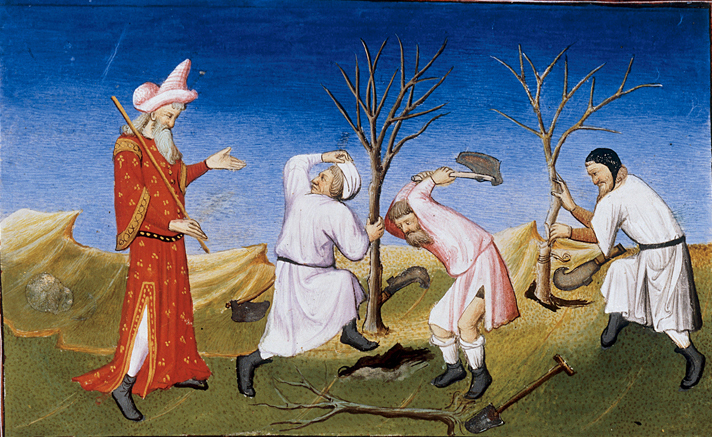A History of World Societies:
Printed Page 342
A History of World Societies Value
Edition: Printed Page 340
Chapter Chronology
The Movement of Peoples
The Mongols had never looked down on merchants the way the elites of many traditional states did, and they welcomed the arrival of merchants from distant lands. Even when different groups of Mongols were fighting among themselves, they usually allowed caravans to pass without harassing them.
The Mongol practice of transporting skilled people from the lands they conquered also brought people into contact with each other in new ways. Besides those forced to move, the Mongols recruited administrators from all over. Especially prominent were the Uighur Turks of Chinese Central Asia, whose familiarity with Chinese civilization and fluency in Turkish were extremely valuable in facilitating communication. Literate Uighurs staffed much of the Mongol administration.
One of those who served the Mongols was Rashid al-Din (ca. 1247–1318). A Jew from Persia and the son of an apothecary, Rashid al-Din converted to Islam at the age of thirty and entered the service of the Mongol Il-khan of Persia as a physician. He rose in government service, traveled widely, and eventually became prime minister. Rashid al-Din became friends with the ambassador from China, and together they arranged for translations of Chinese works on medicine, agronomy, and statecraft. Aware of the great differences between cultures, he believed that the Mongols should try to rule in accord with the moral principles of the majority in each land. On that basis he convinced the Mongol khan of Persia to convert to Islam. Rashid al-Din undertook to explain the great variety of cultures by writing a world history more comprehensive than any previously written. (See “Viewpoints 12.2: Circulating Paper Money.”)
The Mongols were remarkably open to religious experts from all the lands they encountered. More Europeans made their way as far as Mongolia and China in the Mongol period than ever before. Popes and kings sent envoys to the Mongol court in the hope of enlisting the Mongols on their side in their long-standing conflict with Muslim forces over the Holy Land. European visitors were also interested in finding Christians who had been cut off from the West by the spread of Islam, and in fact there were considerable numbers of Nestorian Christians in Central Asia. In 1245 Pope Innocent IV wrote two letters to the “King and people of the Tartars” asking him to become a Christian and cease attacks against Europe. They were delivered to a Mongol general in Armenia. The next year another envoy, Giovanni di Pian de Carpine, reached the Volga River and the camp of Batu, the khan of the Golden Horde. Batu sent him on to the new Great Khan in Karakorum with two Mongol guides, riding so fast that they had to change horses five to seven times a day. Their full journey of more than three thousand miles took a remarkably short five and a half months. Carpine spent four months at the Great Khan’s court but never succeeded in convincing the khan to embrace Christianity or drop his demand that the pope appear in person to tender his submission to the khan. When Carpine returned home, he wrote a report that urged preparation for a renewed Mongol attack on Europe. The Mongols had to be resisted “because of the harsh, indeed intolerable, and hitherto unheard-of slavery seen with our own eyes, to which they reduce all peoples who have submitted to them.”4
A few years later, in 1253, Flemish friar William of Rubruck set out with the permission of King Louis IX of France as a missionary to convert the Mongols. He too made his way to Karakorum, where he found many Europeans. At Easter, Hungarians, Russians, Georgians, Armenians, and Alans all took communion in a Nestorian church.

Planting Trees The illustrations in early copies of Marco Polo’s book show the elements that Europeans found most interesting. This page illustrates Khubilai’s order that trees be planted along the main roads. (Illumination fromLe Livre des Merveilles du Monde [Travels of Marco Polo], by the Paris studio of the Boucicaut Master, c. 1412/Bibliothèque Nationale, Paris/akg-images)
The most famous European visitor to the Mongol lands was the Venetian Marco Polo (ca. 1254–1324). In his famous Travels, Marco Polo described all the places he visited or learned about during his seventeen years away from home. He reported being warmly received by Khubilai, who impressed him enormously. He was also awed by the wealth and splendor of Chinese cities and spread the notion of Asia as a land of riches. In Marco Polo’s lifetime some skeptics did not believe his tale, and even today some scholars speculate that he may have learned about China from Persian merchants he met in the Middle East without actually going to China. But Mongol scholars staunchly defend Marco Polo, even though they admit that he stretched the truth to make himself look good in several places.
